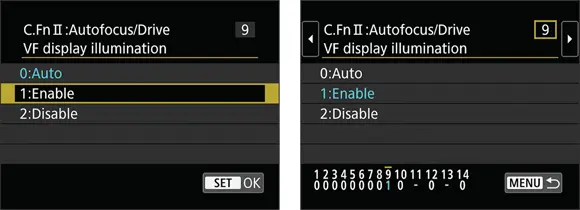1 ...8 9 10 12 13 14 ...19 Selecting a menu or menu page: You have these options: Touchscreen: Tap the menu icon to select that menu; tap a page number to display that page. Quick Control dial or Main dial: Press the right or left edge of the Quick Control dial or rotate the Main dial to scroll through the menu icons. With either technique, you have to scroll through all pages of a menu to get to the neighboring menu. As you scroll through the menus, notice the color coding: red for the Shooting menu, blue for the Playback menu, purple for the Network menu, orangey-yellow (ochre?) for the Setup menu, teal for Display Level Settings, and green for My Menu.
Select and adjust a menu setting: Again, you have a choice of techniques: Touchscreen: Tap the menu item to display options for that setting. The current setting is highlighted; tap another setting to select it. On some screens, you see a Set icon; if it appears, tap that icon to lock in your selection and exit the settings screen. Quick Control dial and Set button: Press the top or bottom edge of the Quick Control dial to highlight the menu option and then press the Set button to display the available options for that setting. Press the edges of the Quick Control dial up, down, right, or left as needed to scroll to the setting you want to select. Then press the Set button to lock in your choice. You can mix and match techniques, by the way. For example, even if you access a menu option via the Quick Control dial, you can use the touchscreen to select a setting.
Instructions from this point forward assume you don’t need to be told the specifics of how to select menus and menu options at every turn. So instead of stepping you through each button press or touchscreen tap required to adjust a setting, instructions simply say something like “Choose Image Quality from Shooting Menu 1.” If choosing a menu option involves any special steps, however, I provide guidance.
Navigating Custom Functions
Custom Functions are a group of advanced settings available only in the P, Tv, Av, and M exposure modes. ( Remember: You set the exposure mode via the Mode dial on top of the camera.)
To explore Custom Functions, choose that item from Setup Menu 5, as shown on the left in Figure 1-19. You then see the options screen for a specific Custom Function, as shown on the right in the figure. Here’s a guide to using the Custom Function screens:
Interpreting the screens: The Custom Functions screens are a little intimidating until you know what’s what: Custom Functions are grouped into three categories: Exposure, Autofocus/Drive, and Operation/Others. The category number and name appear in the upper-left corner of the screen. In the right screen in Figure 1-19, for example, the label indicates that you’re looking at a screen from the Autofocus/Drive category. (C.Fn II refers to Custom Functions group two.)The number of the selected function appears in the upper-right corner. Custom Function 9 is shown on the right in Figure 1-19. Settings for the function appear in the middle of the screen. Blue text indicates the current setting. The default setting is represented by the number 0. So in Figure 1-19, Auto is selected and is the default setting. Numbers at the bottom of the screen show you the current setting for all Custom Functions. The top row of numbers represents the Custom Functions, with the currently selected function indicated with a tiny horizontal bar over the number (9, in the figure). The lower row shows the number of the current setting for each Custom Function; again, 0 represents the default.For Custom Functions 11 and 13, you instead see a dash, which is Canon’s way of letting you know that this menu option controls more than one camera setting (thus there isn’t a single default setting). FIGURE 1-19:Choose Custom Functions from Setup Menu 5 to access additional customization options.
Scrolling from one Custom Function to the next: Press the left or right edge of the Quick Control dial or tap the left or right scroll arrows at the top of the screen. You can see the arrows in the right screen in Figure 1-19.
Changing the setting: Activate the menu item by pressing the Set button or tapping one of the available setting options. The screen changes to look similar to the one shown on the left in Figure 1-20. To select an option, tap it or press the top or bottom edge of the Quick Control dial to move the yellow selection box over it.If you see up/down arrows on the right side of the screen, you need to scroll the menu screen to view all the available setting options. To do so, tap those arrows or press the top/bottom edge of the Quick Control dial.To lock in your setting and deactivate the settings screen, tap the Set icon or press the Set button. The screen returns to its inactive state, as shown on the right in Figure 1-20. The setting you selected appears in blue, and the row of digits at the bottom of the screen reflects the number for that setting. A blue number indicates that you chose a setting other than the default.
Exiting the Custom Functions submenu: Tap the Menu icon in the lower-right corner of the screen or press the Menu button. Press Menu again to exit the menu system entirely and return to shooting.

FIGURE 1-20:After you select a setting (left), the initial menu screen updates to reflect your choice (right).
Customizing the Touchscreen
When the camera’s touchscreen is enabled, as it is by default, you can simply touch the monitor to choose menu commands, change picture settings, scroll through your pictures, and more.
How you touch the screen depends on the task at hand. Here’s a rundown of the names assigned to various touchscreen moves, or gestures:
Tap: Tap a finger on the monitor. (Figures and instructions throughout the book indicate where to tap.)
Drag: Using light pressure, drag your finger across the screen. On some menu screens, for example, you can drag up or down to scroll through a list of options.
Swipe: Drag one or two fingers quickly across the screen. You use this gesture, known in some circles as a flick, to scroll through your pictures in playback mode, just as you do when showing off your photos on a smartphone.
Pinch in/pinch out: To pinch in, place your thumb at one edge of the screen and your pointer finger at the other. Then drag both toward the center of the screen. To pinch out, start in the center of the screen and swipe both fingers outward. Pinching is how you zoom in and out of pictures during playback.
 You can customize the following aspects of the touchscreen’s behavior:
You can customize the following aspects of the touchscreen’s behavior:
Adjust (or disable) touchscreen response: You can choose from three settings, accessed via the Touch Control option, found on Setup Menu 3. Standard is the default, setting the screen to respond to a “normal” amount of pressure. Don’t ask how the Powers That Be decided what that pressure level is — just know that if your normal pressure doesn’t evoke a response, you can change the setting from Standard to Sensitive. Choose Disable to make the touchscreen totally inactive.
Silence the touchscreen: By default, the touchscreen emits a tiny “boop” with every tap. If you find that annoying, choose the Beep option, found just beneath the Touch Control option on Setup Menu 3. The option that hushes the boop is Touch to Silence — silence indicated by a little speaker with a slash through it. The Disable setting turns off touchscreen sounds and the beep the camera emits when focus is achieved.
Читать дальше


 You can customize the following aspects of the touchscreen’s behavior:
You can customize the following aspects of the touchscreen’s behavior:










